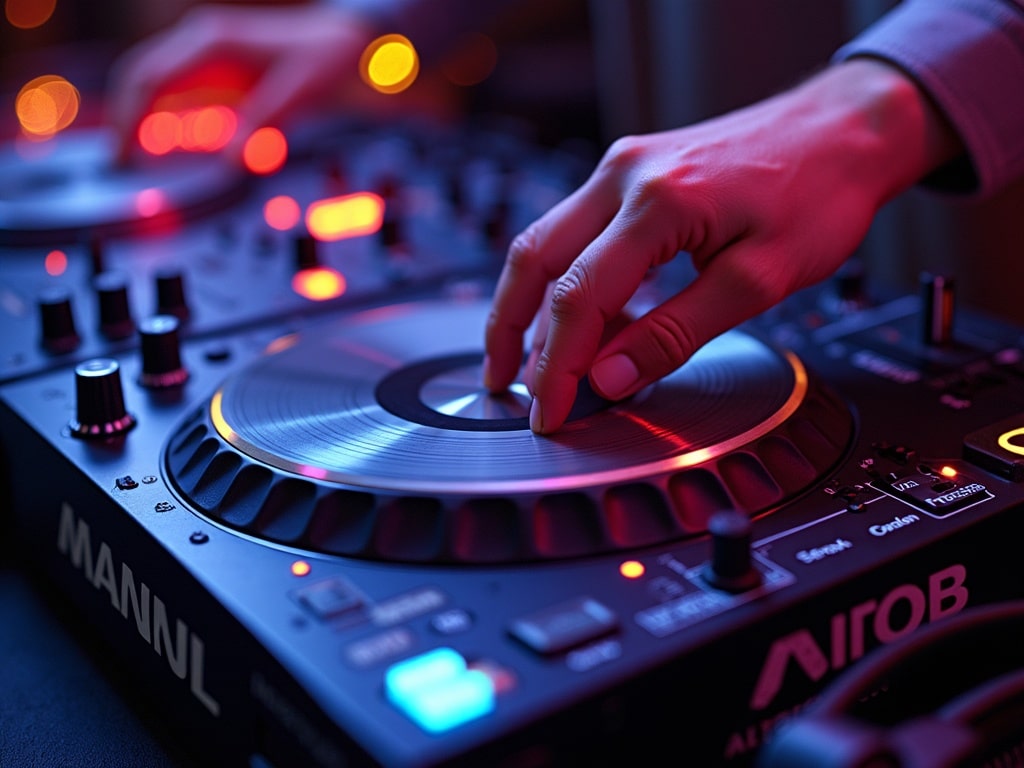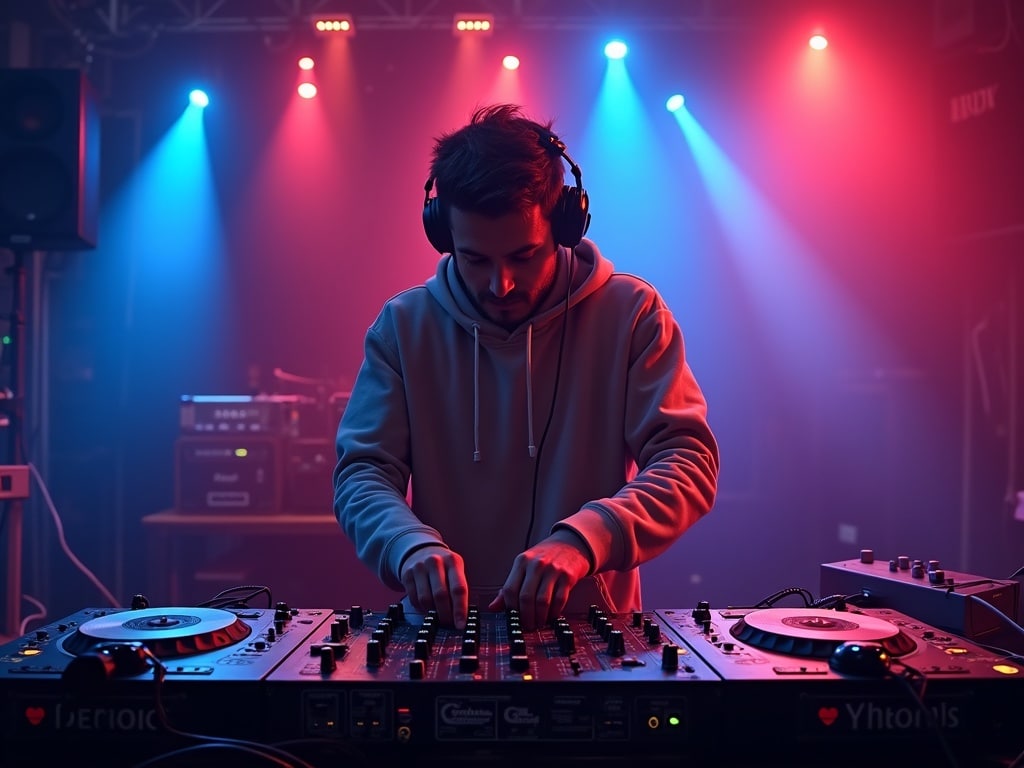Easy DJ Tutorial: Master the Basics & Throw Your First Awesome Party Tonight!
What is DJing and Its Evolution?
DJing, at its core, is the art of selecting and playing recorded music for an audience. But it's so much more than just pressing play. It's about crafting an experience, building energy, and connecting with people through sound. Imagine the thrill of controlling the vibe, making people move their feet, and creating memories that last a lifetime. That's the power of DJing.
The journey of DJing began in the early 20th century, evolving from radio broadcasting to mobile disco setups. The real turning point came with the rise of hip-hop in the 1970s, where DJs like Kool Herc pioneered techniques like breakbeat mixing, laying the foundation for modern DJ culture. From vinyl to CDs to digital files, the technology has changed, but the essence of connecting with the crowd through music remains the same. Today, DJing encompasses diverse genres and styles, from house and techno to hip-hop and pop, with each DJ bringing their unique flavor to the mix.
Essential DJ Equipment for Beginners: What You Really Need?
Don't get intimidated by flashy setups! Starting as a DJ doesn't require breaking the bank. Here's a breakdown of the essentials:
- DJ Controller: This is your command center. It emulates turntables and a mixer, all in one convenient device. Look for controllers with jog wheels for scratching, faders for volume control, and knobs for EQ adjustments.
- DJ Software: The brains of the operation. Software like Serato DJ Lite, Traktor DJ, or Rekordbox DJ allows you to load, manipulate, and mix your music. Many controllers come bundled with a free version of DJ software to get you started.
- Laptop or Computer: To run your DJ software and store your music library. A decent processing speed and ample storage are key.
- Headphones: Crucial for cueing up the next track and beatmatching without the audience hearing. Closed-back headphones are ideal for blocking out external noise.
- Speakers or Sound System: To amplify your music for your audience. Depending on the size of your venue (your bedroom versus a party), you'll need powered speakers or a connection to an existing sound system.
Nice-to-haves include studio monitors for accurate audio playback when practicing at home, and a microphone for announcements and interacting with the crowd.
Understanding DJ Software: Free and Paid Options
Picking the right DJ software is like choosing the right co-pilot for your musical journey. Here’s a quick rundown of popular options:
- Serato DJ Lite/DJ Pro: Known for its user-friendly interface and intuitive workflow. Serato DJ Lite is a great free option for beginners, while DJ Pro unlocks advanced features for seasoned DJs.
- Traktor DJ/Traktor Pro: Popular among electronic music DJs, Traktor offers powerful effects, remix decks, and customizable options.
- Rekordbox DJ: Seamlessly integrates with Pioneer DJ equipment and allows you to prepare your music library in advance for smooth performances.
- VirtualDJ: A feature-rich software with a vast library of built-in effects and a user-friendly interface.
Experiment with trial versions to see which software clicks with your style. Don't feel pressured to buy the most expensive option right away. Start with a free or entry-level version and upgrade as your skills progress.
Music Selection for DJs: How to Build Your Library?
A DJ is only as good as their music library. The foundation of any great DJ set is a well-curated collection of tracks that resonate with you and your target audience. How do you build that treasure trove of tunes?
- Explore Music Streaming Services: Spotify, Apple Music, Tidal, and Beatport offer vast libraries of music. While you can't directly use tracks from Spotify or Apple Music in DJ software (due to licensing restrictions), they are invaluable for discovering new music and creating playlists. Beatport is specifically geared towards DJs, offering high-quality tracks for purchase.
- Dig Through Online Music Stores: Platforms like Bandcamp and Juno Download offer a wide variety of genres and independent artists.
- Embrace Vinyl (If You're Feeling Retro): Nothing beats the tactile experience of spinning vinyl. Explore record stores and online marketplaces for classic tracks and hidden gems.
- Organize Your Music: Create playlists based on genre, mood, energy level, or specific events. Tag your tracks with relevant keywords for easy searching.
Most importantly, listen to music actively. Pay attention to song structure, rhythm, and energy. This will help you understand how to blend tracks together seamlessly and create engaging DJ sets.
Beatmatching Basics: A Step-by-Step Guide
Beatmatching is the cornerstone of DJing. It's the art of synchronizing the tempos of two songs so they play in perfect time with each other. Here's a beginner-friendly guide:
- Load Two Tracks: Load two tracks into your DJ software or onto your turntables.
- Identify the BPM: Determine the BPM (beats per minute) of each track. Most DJ software automatically displays the BPM.
- Use Headphones to Cue: Listen to the track you want to mix in through your headphones.
- Adjust the Pitch: Use the pitch fader on your controller or turntable to adjust the tempo of the incoming track until it matches the BPM of the playing track.
- Fine-Tune with Jog Wheels: Use the jog wheels to nudge the incoming track forward or backward in time to keep it perfectly in sync with the playing track.
- Listen Carefully: Pay close attention to the kick drums and snares. If they sound like they are clashing or out of sync, make further adjustments to the pitch or jog wheels.
Keep practicing! Beatmatching takes time and patience. The more you practice, the better you'll become at hearing the subtle differences and making quick adjustments.
Mixing Techniques for Beginners: Fades, Cuts, and More
Once you've mastered beatmatching, it's time to explore basic mixing techniques:
- Fades: A smooth transition where you gradually increase the volume of the incoming track while simultaneously decreasing the volume of the outgoing track.
- Cuts: A more abrupt transition where you quickly switch from one track to another using the crossfader.
- EQing: Adjusting the equalizer (bass, mids, and highs) of each track to create space for the incoming track and prevent muddiness. Lowering the bass on the incoming track while the outgoing track's bass is prominent is a common technique.
- Using the Crossfader: This is the lever that blends the left and right channels. Experiment with different crossfader curves to find what works best for you.
Start with simple fades and cuts, and gradually incorporate EQing as you become more comfortable. The key is to keep the energy flowing and avoid jarring transitions.
Creating Smooth Transitions: Tips and Tricks
Smooth transitions are the hallmark of a skilled DJ. Here are some tips to elevate your mixing game:
- Match the Energy: Choose tracks with similar energy levels to maintain a consistent vibe on the dance floor.
- Use Phrase Matching: Start your transition at the beginning of a phrase (usually 4 or 8 bars) to create a natural flow.
- Tease the Incoming Track: Gradually introduce elements of the incoming track, such as the melody or a vocal sample, before fully transitioning.
- Create Tension and Release: Build anticipation before a drop by slowly increasing the volume of the incoming track and adding effects.
Listen to professional DJ mixes to learn from the best. Pay attention to how they transition between tracks and try to emulate their techniques.
Understanding Music Structure: Intros, Outros, and Breaks
To create seamless mixes, you need to understand the anatomy of a song. Most dance music tracks follow a similar structure:
- Intro: The beginning of the track, typically instrumental with a build-up in energy.
- Verse: A section with vocals that tells a story or expresses an idea.
- Chorus: The main hook of the song, usually the most memorable and catchy part.
- Break: A section with a stripped-down arrangement, often featuring instrumental melodies or sound effects.
- Drop: The climax of the song, where the energy peaks and the beat becomes more intense.
- Outro: The ending of the track, often similar to the intro.
Knowing the structure of a song allows you to anticipate transitions and choose appropriate mixing points. For example, you might transition from the outro of one track to the intro of another, or use a break to create a smooth transition between two tracks with different energy levels.
Setting Up Your DJ Equipment for a Party: Connections and Wiring
Getting your equipment set up correctly is essential for a smooth and stress-free performance. Here's a basic guide to connections and wiring:
- Connect Your Controller to Your Computer: Use a USB cable to connect your DJ controller to your laptop or computer.
- Connect Your Headphones: Plug your headphones into the headphone jack on your controller.
- Connect Your Speakers: Connect your speakers to the main outputs on your controller. Use RCA cables or XLR cables depending on the type of connections on your speakers.
- Connect a Microphone (Optional): If you're using a microphone, plug it into the microphone input on your controller or mixer.
- Test Your Sound: Play a track and make sure the sound is coming through your speakers and headphones. Adjust the volume levels as needed.
Keep your cables organized and out of the way to prevent tripping hazards. Consider using cable ties or a cable organizer to keep everything tidy.
Choosing the Right Music Genre for Your Audience
A successful DJ set depends on understanding your audience and playing music that resonates with them. Before you start playing, consider these factors:
- The Venue: What type of venue are you playing at? A club, a bar, a wedding, or a private party? Each venue has a different vibe and a different type of audience.
- The Demographics: What is the age range of your audience? What are their musical preferences?
- The Occasion: What is the occasion for the event? A birthday party, a holiday celebration, or a corporate event?
Once you have a good understanding of your audience, choose a music genre that is appropriate for the occasion. If you're unsure, start with a mix of popular genres and observe how the audience responds. Be prepared to adapt your set based on the crowd's reaction. An open-format approach, spanning different genres, can often be a crowd-pleaser, especially when you're just starting and getting to know your audience's tastes.
Building a DJ Set: Planning Your Music Flow

A well-structured DJ set is like a captivating story, with a beginning, middle, and end. Here's how to plan your music flow:
- Start with a Warm-Up: Begin with mellow tracks to ease the audience into the groove.
- Build the Energy: Gradually increase the tempo and intensity of the music as the set progresses.
- Create Peaks and Valleys: Alternate between high-energy tracks and more relaxed tracks to keep the audience engaged.
- End with a Bang (or a Chill Vibe): Finish with a powerful track to leave a lasting impression, or wind down with slower, more mellow tunes, depending on the event's atmosphere.
Use a music management software like Rekordbox or Serato to create playlists and organize your tracks in advance. This will help you stay organized and ensure a smooth flow throughout your set.
Reading the Crowd: Responding to the Dance Floor
A great DJ is not just a music player; they're a crowd reader. Pay attention to the audience's reaction to your music. Are they dancing? Are they singing along? Are they looking bored? Use this feedback to adjust your set in real-time.
- Observe Body Language: Are people moving their feet and nodding their heads? Or are they standing still and talking amongst themselves?
- Listen to Verbal Cues: Are people requesting certain songs or genres?
- Adapt Your Style: If the crowd isn't responding to your current selection, switch to a different genre or tempo.
Don't be afraid to experiment and try new things. The more you play in front of an audience, the better you'll become at reading their reactions and tailoring your set to their tastes.
Using Effects: Enhancing Your Mixes
Effects can add spice and creativity to your DJ mixes. Experiment with effects such as:
- Reverb: Adds a sense of space and depth to the sound.
- Delay: Creates an echo effect.
- Flanger: Creates a swirling, jet-like sound.
- Filter: Cuts off certain frequencies, creating a sweeping effect.
Use effects sparingly and tastefully. Too many effects can sound muddy and overwhelming. Practice using effects in your headphones before incorporating them into your live sets.
Recording Your Mixes: Sharing Your Talent
Recording your mixes is a great way to showcase your talent, get feedback, and build your online presence. Most DJ software has a built-in recording feature. Simply press record and let it run while you mix.
Once you've recorded your mix, you can upload it to platforms like:
- Mixcloud: A platform specifically designed for DJ mixes and radio shows.
- SoundCloud: A popular platform for sharing all types of audio content.
- YouTube: Create a video with visuals to accompany your mix.
Promote your mixes on social media and other online platforms to reach a wider audience.
Promoting Yourself as a DJ: Online and Offline Strategies
Getting your name out there is crucial for building a successful DJ career. Here are some online and offline strategies:
- Create a Website or Online Portfolio: Showcase your mixes, biography, and upcoming events.
- Use Social Media: Use platforms like Instagram, Facebook, and Twitter to connect with fans, promote your gigs, and share your music.
- Network with Other DJs and Promoters: Attend local events and connect with other DJs and promoters.
- Play Free Gigs: Offer to play at local bars, restaurants, or private parties to gain experience and exposure.
- Create Business Cards: Hand out business cards to potential clients and fans.
Be consistent with your promotion efforts. Regularly update your website and social media accounts, and actively engage with your audience.
Overcoming Common DJ Mistakes: Troubleshooting Tips
Everyone makes mistakes, especially when they're starting out. Here are some common DJ mistakes and how to avoid them:
- Poor Beatmatching: Practice beatmatching regularly to improve your skills.
- Awkward Transitions: Plan your transitions in advance and pay attention to the energy levels of your tracks.
- Playing the Wrong Music: Know your audience and choose music that they will enjoy.
- Overusing Effects: Use effects sparingly and tastefully.
- Technical Difficulties: Test your equipment before each gig and bring backup cables and equipment.
Don't be afraid to learn from your mistakes. Every mistake is an opportunity to improve your skills and become a better DJ.
DJ Etiquette: Respecting the Music and the Audience
DJing is not just about playing music; it's about respecting the music, the audience, and the venue. Here are some important DJ etiquette rules:
- Be Punctual: Arrive on time for your gigs.
- Respect the Venue's Rules: Follow the venue's rules regarding volume levels, music selection, and other restrictions.
- Be Professional: Dress appropriately and act professionally.
- Respect Other DJs: Don't try to steal other DJs' gigs or play their signature tracks.
- Be Grateful: Thank the venue, the promoter, and the audience for their support.
By following these etiquette rules, you'll build a positive reputation and earn the respect of your peers and fans.
Advanced DJ Techniques: Scratching, Looping, and More
Once you've mastered the basics, you can start exploring advanced DJ techniques such as:
- Scratching: Manipulating the record or jog wheel to create rhythmic sounds.
- Looping: Creating repeating sections of a track.
- Sampling: Incorporating short audio clips into your mixes.
- Harmonic Mixing: Mixing tracks that are in the same key or compatible keys.
These techniques require practice and skill, but they can add a new dimension to your DJ sets. Watch tutorials and experiment with different techniques to find what works best for your style.
Exploring Different DJ Styles: From House to Hip-Hop
DJing encompasses a wide range of styles and genres. Explore different styles such as:
- House: Upbeat electronic music with a four-on-the-floor beat.
- Techno: Darker and more repetitive electronic music.
- Hip-Hop: Rhythmic music with rap vocals.
- R&B: Soulful music with smooth vocals.
- Pop: Popular music with catchy melodies.
Experiment with different genres to find your niche. You might even develop your own unique style that blends elements from different genres.
Legal Aspects of DJing: Copyright and Licensing
As a DJ, it's important to understand the legal aspects of playing copyrighted music. You generally need permission from the copyright holders to publicly perform or distribute copyrighted music. This permission typically comes in the form of licenses from performing rights organizations (PROs) like ASCAP, BMI, and SESAC.
Many venues already have licenses that cover the music played by DJs. However, it's always a good idea to check with the venue or promoter to ensure that you are covered. When you are recording and distributing your mixes online, make sure you get permission from the copyright holders, or utilize royalty-free music to avoid legal issues.

